With an area of 506.000 km2, 50 provinces with several metropolises such as Barcelona, Valencia or Seville and many rural regions, Spain offers potential for a wide range of mobility solutions. A closer look at the public transport system shows that Spain has invested the most in new infrastructure over the last 20 to 30 years compared to other countries in Europe. This is especially true for the metro network in the metropolitan areas. A large part of the Spanish population (approx. 80.8%) lives in the big cities, but connections to rural areas are just as well available. The Spanish bus network is much denser than the rail network of the national railway company and connects even the smallest, remote villages with each other. However, the frequency of the bus trips depends on the destination, but also on the season, public holidays, etc. Inadequate timing, often missing direct connections and generally low flexibility make public transport hardly a real alternative to private transport for many inhabitants in rural areas. Therefore, despite their well-developed public transport system, Spaniards like to take taxis. The prices are significantly lower than in Germany, but the negative effect on the environment is also significantly higher. From 2025, old taxis are therefore to be replaced by low-emission or completely emission-free vehicles.
Additionally, Spain has (as part of the European Union) launched various other initiatives to make mobility in the country more sustainable and to minimise car journeys. The capital is setting a positive example in this respect: Madrid has committed itself to significantly reduce its air pollution. To this end, the city has created the “Madrid Central” zone, a 472-hectare environmental zone in the city centre. The “Low-Emission Zone” was approved by the city in 2018, as car traffic was responsible for a significant proportion of emissions there. Recent measurements show that “Madrid Central” is one of the most effective zones in Europe, as it led to a 32% reduction in emissions.
This development has also left its mark on the automotive industry: the ever-increasing restrictions on diesel fuel are encouraging a decline in the number of vehicles of this type. The automotive industry therefore relies primarily on e-cars when developing new vehicles.
At the same time, the country offers fertile ground for new forms of mobility. With the current trend towards sustainability, the Spanish authorities are also increasingly creating incentives to establish new services such as car–sharing, micro-mobility and e-vehicles.
Car–sharing
Especially in metropolises like Madrid, car sharing is a frequently used alternative and is particularly popular with younger residents. In Madrid, a total of over 3,000 vehicles are available, which have been put into operation by car sharing providers such as Ubeeqo, Respiro, Zity, car2go, emov and wible within a period of only four years.
E-Mobility
In 2019, the Spanish government adopted the new edition of its eMobility subsidy program. The focus is on promoting e-vehicles and charging infrastructure in order to achieve the country’s climate goals with the help of electric vehicles.
Taking a look into the future
A study carried out as part of the European Mobility Week shows that 64% of the “digital natives” in Spain are planning a future without a car of their own, compared to 43% of Generation Z (born between 1961 and 1979) and 16% of baby boomers (in their late 40s and early 60s) who would give up owning a private vehicle. This is a clear indication that Spain’s young population is incorporating the sustainability factor into their mobility decisions and is particularly enthusiastic about technological innovations such as autonomous means of transport.



